|
|
|
|
|
Interview with Martin Erik Andersen by Andreas Brøgger, on April 11, 2004
|
| |
|
| | |
|
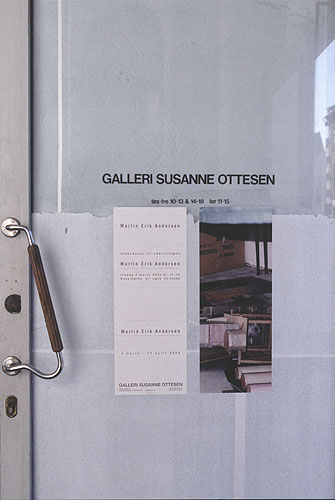 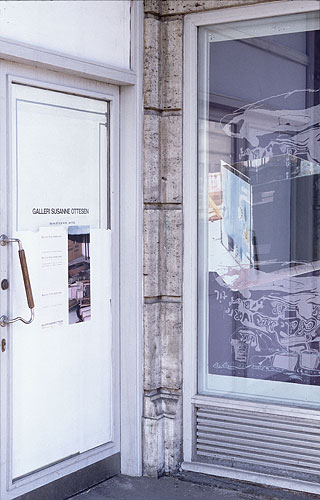
|
| |
|
| | |
|
“Af alle disse værelser er ingen blevet til”
[Of all these rooms, none have come into existence]
is the title of your most recent exhibition
in Galleri Susanne Ottesen. For the occasion,
sheets of white paper covered the inside surfaces
of the gallery’s windows and rendered them opaque.
Was this done to screen off the existence (til-værelsen)
inside the gallery’s space?
|
| |
|
| | |
|
Yes, it is quite correct that the word
“værelse” [room] and its etymological roots in “væren”
([being] serve as the jumping off point for this exhibition.
Quite recently, I was reading Inger Christensen’s Det malede værelse
[The Painted Room] which is a suite of fantastic short stories that C
hristensen composes into and out from Mantegna’s mural in Padua.
In Italian, her book (and also the room) is called “Camera picto”
and it occurred to me that a chamber is something completely different
from our conveniently untranslatable Nordic room: the ‘chamber’
is a box viewed from the outside while a ‘room’ is an existence projected
from the body out into space – the extension of which is stopped by the walls.
Perhaps Inger Christensen has produced her text on the basis of an
untranslatable misunderstanding.
I thought I could work further with this.
The word “værelse” is something that is both
very intimate and very arbitrary and at one and the same time,
it constitutes a generalized architectonic/structural entity,
which installs body, space and language into an entirely special
mutual relation. Mantegna actually breaks up the space into the
illusory glimpses out through the walls – the painting as window
(or the room’s space as “camera obscura”).
This might be the reason that I felt it was the right thing
to start out by reestablishing the windows in the gallery as
boundaries for the space by closing them up. And at the same time,
the act of covering the windows also sets into play some other kinds
of fundamental conditions for the vision. That this eventually
came to be done with tissue paper is actually a whole other tale,
which is connected with a notion about the architectonic as
unreality and as provisional construction, as papier mâché.
|
| |
|
| | |
|
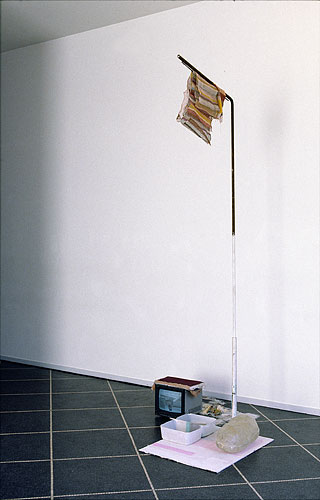 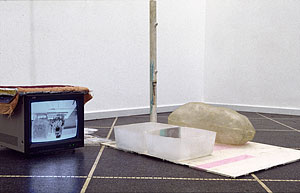
|
| |
|
| | |
|
What is the “song” that we hear at the exhibition in Galleri Susanne Ottesen?
|
| |
|
| | |
|
The ambition in the exhibition has been to establish,
via the sculpture category, a kind of intermediate zone
between the body and the architectonic:
a zone that presumably corresponds to that which
is untranslatable in the relationship between chamber and værelse [room].
Actually I consider myself 100% unmusical,
so the sound has been conceived and used in a spatial way.
The song, which is a physically acoustic phenomenon, of course,
is simply a way of filling the space with an imaginary body.
This, in turn, implies a spectator’s body, physically,
that surrounds the faculty of being able to see.
Naturally, there’s more to it than this; singing,
for example, can also be language without language.
Specifically, I am making use of folk music from Eastern Europe
that is being played backwards. Once again, here we have something
that is all at once arbitrary and general:
at one and the same time, physical and mental – as visual art is.
|
| |
|
| | |
|
When one walks around in the gallery taking
in the different elements of your exhibition,
what eventually becomes clear is that there are
certain connections or couplings spanning across
the different placements and materials.
If I have to put this more precisely, what I mean by “couplings”
is that many of the elements appear to be either “derived” from or
“embedded” in each other: casts; pages from Donald Duck comic books
that are encased in different kinds of surfaces; light projections
that are being reflected; video images that are being transmitted
from one space to another. When there are references
in the installations and thereby some form of “sign”,
they appear in this way to be very closely connected to the spatial and material ….
|
| |
|
| | |
|
Generally speaking, I feel that I am working
with a kind of equality and open transport between
signs and materials.
Material, understood in the sense of substance in itself,
is, of course, situated on the borderline of this total silence and, really,
I’m not so interested in those kinds of totalities anymore.
I think that I prefer the intermediate zones, the transitions,
the openings – and this might be the reason that the elements are
“derived”, “embedded”, partially overlapping, semi-transparent,
reduplicating and transporting. This is not intentional mystification
but rather a series of sincere attempts to open the material and the spatial
equally to the signs and to our bodies. Of course, every now and then, this
deals a hard blow to both the elements and the language – but it is presumably
right there that the artistic meets one of its fundamental obligations.
|
| |
|
| | |
|
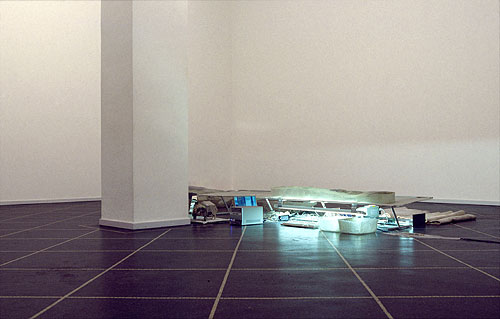
|
| |
|
| | |
|
Can the more immaterial entities,
such as the video images, the reflections and the light projections
(or the “derived” phenomena, in one respect or another)
be apprehended as your mode of challenging this “total material silence”?
|
| |
|
| | |
|
Well, if I am laying down any kind of gauntlet, then I really hope
that I’m doing so on behalf of the silence.
The three aspects of the exhibition that you
have just mentioned are subtly different dimensions from my point of view.
With the video images, we can speak, perhaps,
about a kind of “carrying the battle into the enemy’s camp”.
In the sequencing, the pictures certainly constitute or mimic
one of the narrative’s fundamental structures.
In this particular sequence, the narrative is coupled
with the physical interpretive/reading situation,
which I am trying to render thematic as a material itself:
maybe as a kind of suggestion that the narrative actually
drudges along on a large lump of silence, one of these being the body.
The reflections are (as always) fundamental to our general establishment
of subject-object relations and as such (as always) they are ground elements
of the actual interchange in which the visually artistic rummages about.
With the light, what I wanted to do was to point far
out into a decorative fringe (the amusement park/the discotheque)
and at one and the same time, to let it be the elements’ own light,
in a way, and perhaps, in doing this, to point inside from the blindness
and also outward – from some other place than the body.
|
|
|
|
| | |
|
As we are talking here about the different elements,
will you tell us something about the way you call printed matter
into play in connection with your exhibitions? How is the printed matter
connected to the rest of the contents that you are specifically examining here?
|
| |
|
| | |
|
With the printed matter, we have moved out into the territory of delimitation.
Or, if we want to put this in sculptural terms, we have moved out into the complex
of problems related to the pedestal. I am rather hypersensitive when it comes to
all the graphic markings around things. If it weren’t for some kind of innate
common sense that reminds me to refrain from belaboring the point, I would probably wind
up arguing about how postage stamps are cancelled by the postal service. The delimitation
issues from there, where one’s work is being read by others. And this delimitation
is naturally crucial to both the establishment and the reading of the otherness
which is constituted by the visually artistic. I think that the articles of
printed matter articulate an attempt to secure and contain while simultaneously
softening and pulverizing the boundary that opens into what I’m working with.
The embedded and the derived are not only seated in the works;
they also run across the works … and sometimes over the course of many years;
the photographic can be used for purposes of assessing this,
naturally not in a sufficiently adequate manner, but for illuminating certain points.
The invitations, the posters and graphic production are,
in fact, the visually artistic’s most discursively addressing facet.
I subscribe to the notion that in this process of addressing,
a kind of surplus mind and matter come forth, a kind of exchange – and maybe even,
if people want to accept it, the presentation of a gift.
When somebody receives a gift, they inevitably assign a value to it.
This might also be a way that visual art can truly be creative
within the social context. The gift, the amusement park and the colors
– there is a correlation and of course, there’s also a reverse side.
|
| |
|
| | |
|
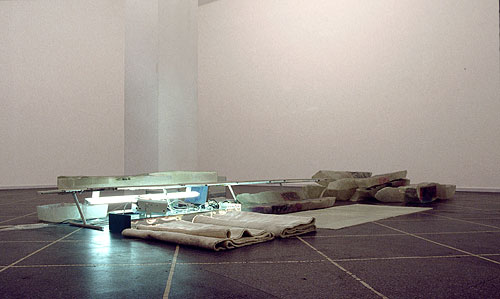
|
| |
|
| | |
|
Can you elaborate on this “reverse side”?
|
| |
|
| | |
|
Well, I guess so; it is Easter,
after all. And basically, I’m a pessimist.
Personally, I suppose I have a rather active take
on the social as some kind of hell.
But perhaps one could also say that it can be just as hard
to believe in what is edifying in the visually artistic as
it must be for the Christian to believe in the corporeal
resurrection of the flesh – and maybe just as unavoidable.
The alternatives are, respectively, bigotry and psychopathy.
|
| |
|
| | |
|
When anybody produces visual art,
what emerges is a constant and concrete
fluttering between artwork and rubbish.
I believe that this fluttering must also be
allotted its place … and even in the result, as well.
In the printed pages that I present as gifts,
it is just as correct or just as wrong to put them
in frames as it is to throw them away. In this way,
I am trying to apportion one circumstance from my
praxis out onto the other side of the interpretive reading.
The reverse side of the gift, then, is presumably its potential
capacity of being rubbish, the abject.
|
| |
|
| | |
|
If we can turn our attention back for a
moment to the printed matter,
would it be possible to draw a parallel between your
remark about the moving images’ “sequencing” and the
“narrative’s fundamental structures” and your strategy
of using text? I’m thinking especially about the titles
of your exhibitions and of the individual works and of your
clipped-out letters in the articles of printed matter that
figure in as rather precise attempts to cut the sequences
up into fragments, in keeping with your will – in spite of everything
– to compile whatever has to be enunciated.
|
| |
|
| | |
|
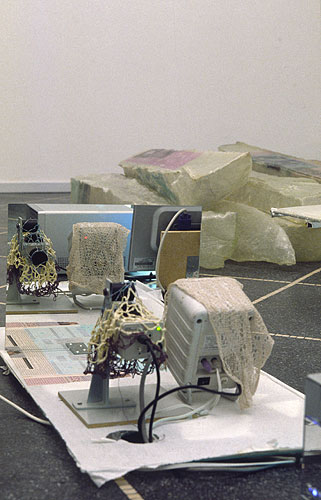 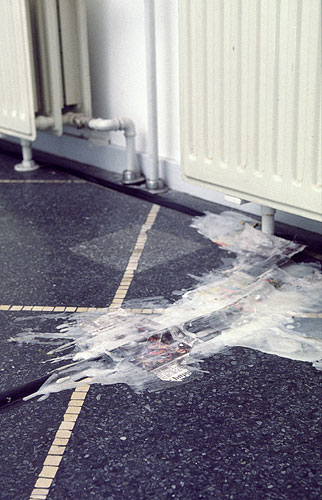
|
| |
|
| | |
|
Again, this is surely an attempt to have the act
of enunciating constructed right into what is being spoken – ergo,
to construct the act of reading into what is being read.
On equal terms. And at the same time, an attempt to keep the determining
factor in the linguistic at a safe distance. For me, there is a straight
line running from what is absurd in using “singing” within the sculpture
category to working with linguistic collapses in the titles.
An intertwining – or maybe even a knitting –
of the manner of thinking together with the material
and of the body together with the alphabet.
|
| |
|
| | |
|
In your artistic practice, certain colors seem to recur,
especially shades of light blue and mauve.
This may not be the most obvious question to put before you,
but what role do the colors play in your works?
I am speculating about whether your use of negative
figures of speech in the printed matter’s photographs have
something to do with your sense about color.
It’s as though the colors and the depicted objects
are not supposed to be unequivocally identified with each other.
|
| |
|
| | |
|
Now that you mention it, this last point is actually not something
I’ve mulled over before, but I have to agree that you’ve formulated
this quite correctly. On the one hand, I cannot work with color
without having it linked somehow to a material register.
On the other hand, there is also the color’s attribute as
a kind of meaning-related glue or perhaps merely as a
transition between disconnected/unbound dimensions and
levels that I am making use of in my work.
A few years ago, I really enjoyed dyeing a cotillion (a Chinese paper
ornament) in chlorine
and trying afterward to glue it back together again
– taking it very seriously all the while as spatial structure.
There might be a parallel here: the colors as a kind of independent
entrance or as an amicable non-linguistic celebration above or
alongside the structural and formal.
Anyhow, it quickly establishes its own system and, accordingly,
I am also frequently choosing colors/materials on the basis
of linguistic spin-offs. Of course, this is very composite.
However, an essential aspect of one’s work as a visual artist
is to open up to – and to close up neatly again to – the composite.
The colors can be employed for both purposes.
|
|
|
|
| | |
|
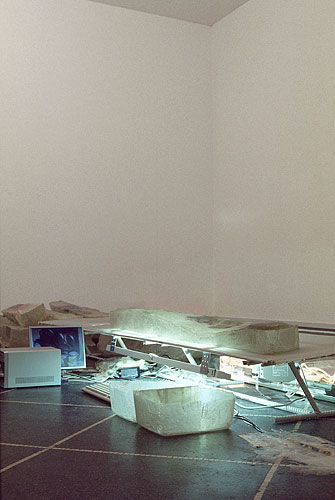
|
| |
|
| | |
|
Lately, you have been using pages
from Donald Duck comic books in your works,
often embedded and cast right into synthetic materials,
smeared/rubbed into beeswax (?) or placed in lateral
inversion with relation to the printed matter.
And the comic strip – as a textual and sensational
sequence that has been framed right into a box –
starts to elicit an interesting effect in relation
to what you’ve been saying here about sequence,
language and color … Is there a connection here or
is there a different kind of logic going on?
Are there certain references that are special for you in
just these pages from the Donald Duck comic books?
|
| |
|
| | |
|
The fact that it happens to be a Donald Duck comic-strip
magazine is ostensibly not really of central importance,
although, of course, the postulate about Duckburg as heterotopia
really is very funny. But closer to the point, perhaps,
is that it has to do with working with the dissolution of
the narrative in materiality. Wax partially penetrates its
way through the paper in an almost translucent way, so that
the front side and the back side are superimposed on top of
each other. And in this way, with the coupling of wax and
comic strip, we are actually driving tangibly into the memory
of sense impressions that so many of us share.
This must be something that teacher training seminars, at some point
in time, put into circulation: something about dripping candle wax
on comic strips, removing the paper afterward and then hanging the
transferred laterally-reversed pictures on a suspended cord.
Since I am trying to get a grasp on this diminutive field,
the explanation for my efforts is that it can support a
bodily experience that, for a certain period of time,
we share in common – one that lies on the other side of the spoken word –
an experience in childhood, supposedly situated on the verge of where
narrative structure becomes established as common linguistic capability
– something that, once again, is simultaneously very specific and very general.
Of course, this is actually an element that is akin to papier mâché –
a democratic material that points toward community, pragmatics and temporariness.
I am very pleased to be laying it down right on top of
the electric wires and the power supply.
|
| |
|
| | |
|
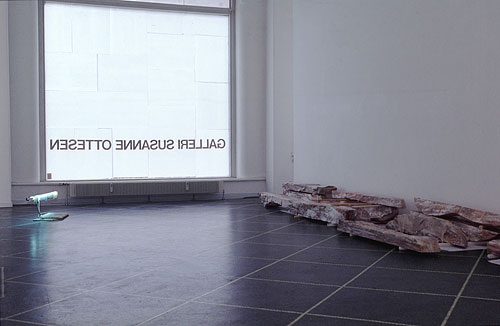
|
| |
|
| | |
|
On a number of occasions, you have introduced religious or
mythological dimensions into your artworks, such as the Kaba shrine in Mecca,
Oriental carpets and John the Apostle. When did cultural material start
to gain your interest? Are you often looking for material in – or outside of
– a particular culture group?
|
| |
|
| | |
|
I have an open and eclectic relationship to the cultural:
if I can put it to any use, then I do so. I’m not harboring any
confessional or anthropological scruples. I am trying to apprehend
the frames for the relations among body, space, sociality and history
that constitute whatever I can experience as reality … and of course,
with a special attention focused on that which is situated right on
the edge or just outside one’s frames of understanding.
This is what I’m using the sculpture category for doing;
with visual art, you can glimpse the edge of your own blindness.
In other places – and at other times – it has been the religious,
in all its obscure forms, that has served as a potential space for
these kinds of reconnaissances and constructions. I dare say,
it is the material as such that absorbs my interest,
in its capacity as a trail of possible parallel investigations that
can be used, perhaps, as bearing marks in relation to that which
cannot be understood. But this is not tantamount to saying that
I think the artistic is supposed to have taken over the place of the religious.
It’s not as simple as all that.
And then I guess that I cannot get around the fact
that my primary cultural group is the expanded sculptural notion,
anchored in a continental European tradition that does not extend
back much further than the 1960s. The other stuff is kind of transcriptions.
|
| |
|
| | |
|
How are you addressing yourself as a sculptor to relations
that are as complex as globalization and fundamentalism?
|
| |
|
| | |
|
Well, you are putting your question to me as a ‘sculptor’ and not as a ‘citizen’. In doing so, you are accordingly asking me how I think the visually artistic is related to the mega-political. Naturally, it’s almost impossible to survey and assess this mutual relation in its entirety. It does appear to be the case that quite possibly, we are standing smack dab in the middle of an all-inclusive social catastrophe. Unfortunately, I’ve got to admit that I see a lot of finely executed visual art which, in any event, seems to be glorifying this catastrophe. And then again, naturally, there are also qualified utopian bids on a directly political kind of art. But once again, I have to admit that this kind of bid does not affect me. The kind of visual art that I am working with myself certainly does not stand in any kind of primary relationship to day-to-day politics. But perhaps it stands, for all that, even more imminently in a very genuine relation to certain micro-political and fundamental dynamics within the social exchanges and consequently within the socially cohesive force that cannot be covered by conventional political agendas. And in this capacity, this kind of art might just come to be one aspect of a culture that can be constituted as a subtly balanced and responsible counter-response to the voidness of the fiction culture and the stupidity of fundamentalism.
In practice, the visually artistic that we know is, to be sure, always aimed at a larger world, at greater diversity, at more richly varied nuances and toward the meek. We can certainly keep hoping, even if it’s easier to be afraid.
|
| |
|
|
|
|
|
translated by Dan Marmorstein |
|
|
|
download PDF version |
|
|
|
|
|
|
|
|
|
|









